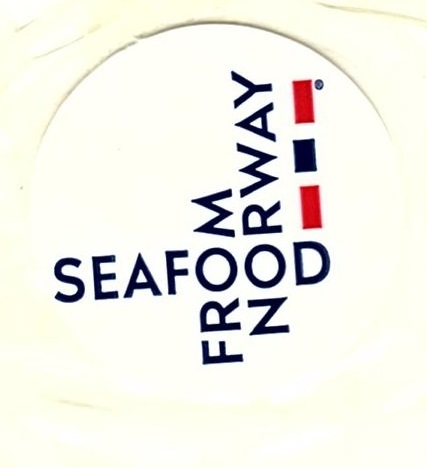Sustainable: The Daily Telegraph recently wrote about choosing sustainable fish. They said that once upon a time, we chose seafood according to what we liked or could afford, with little thought to sustainability. They say we now know better. The Marine Conservation Society estimates that 90% of fish stocks are fully or over-exploited but whilst most consumers want to make responsible choices, the paper says it’s far more complicated that many of us realise. They suggest that If you consult the MCS’s Good Fish Guide, choosing the most sustainable fish (green) and avoiding the worst (red) requires a marine biology degree.
I couldn’t agree more. I have waited for some years for someone to echo my view on the Marine Conservation Society approach to sustainability, but most newspapers have tended to print the MCS press releases, rather than actually ask the question. The reality is the Marine Conservation Society is totally out of touch with how the consumer shops and buys fish. The Good Fish Guide is absolutely of no help in the decision process.
The Daily Telegraph says that it is not just the species that’s important but also you need to know where and how the fish is caught. The paper spoke to Charlotte Coombes, the manager of the Good Fish Guide who said that she appreciates that it’s complicated. She used sea bass as an example of why it is important to know the origin of the fish and how it was caught.
She says that sea bass caught in the Bay of Biscay is on their red list because unsustainable fishing practices are killing increasing numbers of dolphins and porpoises but sea bass is not caught in this way in British waters and can be an OK choice, although still not recommended. Farmed sea bass is better.
I am just going to repeat this to clarify what Charlotte Coombs said, after all, sea bass sales have boomed during lockdown and the fish has become extremely popular:
Sea bass from the Bay of Biscay is on the red list because of the way fishing methods can have an unacceptable by-catch
Sea bass from UK waters is OK but not recommended
Farmed sea bass is better.
I consulted the ‘Good Fish Guide’, and found twenty entries for wild sea bass, twelve of which relate to the Bay of Biscay. Four of these are rated 5 (red list) four are rated 4 and the other four are rated 3.
The MCS state that:
“Rating 5 (red) is associated with fish to be avoided on the basis that all or most of the criteria for sustainability have not been met”.
“Rating 4 (orange) should not be considered sustainable, and the fish is likely to have significant environmental issues associated with its production. While it may be from a deteriorating fishery, it may be one which has improved from a 5 rating, and positive steps are being taken. However, MCS would not usually recommend choosing this fish”.
“Rating 3 (yellow) based on available information; these species should probably not be considered sustainable at this time. Areas requiring improvement in the current production may be significant. Eat only occasionally and check www.goodfishguide.org for specific details”.
The remaining eight entries are for waters around the UK. Two of these are rated 3 and the other six are rated 4.
So according to the Good Fish Guide, consumers can eat, only occasionally, sea bass caught by one third of fishing methods from the Bay of Biscay. They can also eat occasionally, sea bass caught by one quarter of the fishing methods from around the UK. Neither are recommended by the guide, but clearly the claims made by Charlotte Coombs about the Bay of Biscay and UK waters are both incorrect.
She says that eating farmed sea bass is better and of course, I would agree. The Good Fish Guide lists four options which include three rated 3 and one rated 4. The only difference between them is that the three have been certified by Global Gap, ASC or GAA BAP. The fourth option is fish that have not been certified.
However, the real point that comes out from this article is that whilst Charlotte Coombs suggests that it is better to eat farmed, than wild caught from UK waters or than wild caught from the Bay of Biscay, there are fish from each of these groups that are rated identically as a rating of 3. Therefore, according to the guide, there is no real difference between any of three.
It seems that the Telegraph newspaper is not alone in being confused. I was interested to see that reality star Dani Dyer has featured on a video promoted by Seafish as part of the new ‘Love Seafood’ campaign. The video can be viewed at https://www.youtube.com/watch?v=3snPRFK-Hkg. She visits Osborne Brothers Seafood Merchants from Leigh-on-Sea where they discuss what fish they will cook and eat. Dani chose the skate.
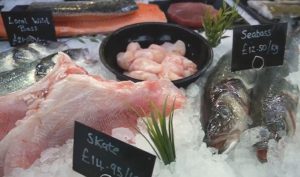
In the video, the fish is clearly labelled as skate, yet the Good Fish Guide lists the fish as on the red list with a rating of 5.

Sometimes, even the MCS appear confused as in the case of Bluefin tuna, which has a rating of ‘?’.

I mention Bluefin tuna because the UK Government appears to be encouraging UK consumers to be eating it. The Metro newspaper reports that the new UK Japan trade deal, which takes effect from January 2021 will include the fish. The Gov.UK website further states that British consumers are to benefit from cheaper high-quality Japanese goods including Bluefin tuna. The tariff on the fish will be reduced from 20% to zero. Perhaps, as a result, we will see an influx of Bluefin tuna into the UK despite the MCS’s uncertainty. Perhaps they have not taken into consideration that the Marine Stewardship Council have certified some Bluefin tuna stocks as sustainable.
How can any consumer make sense of the MCS’s recommendation when their manager can’t get it right and when Seafish promote a species that is on the red list? It is not a marine biology degree that is needed but a realism that consumers choose what they want and don’t really take any notice of the recommendations made by the MCS. If they did, then salmon would not be the UK’s favourite fish.
The MCS Good Fish Guide rates farmed Atlantic salmon as either 1, 2 or 3. In their opinion, salmon grown in recirculation systems are a best choice and rated 1. The fact that they admit that no standard exists for this method of production appears to suggest that the ratings might have more to do with perception than fact.
Salmon, that are produced as organic or are certified by the ASC are rated 2, whilst, those that are Global GAP or GAA BAP certified together with other salmon grown in Scotland, Faroes or Norway are rated 3 with salmon from Chile rated 4.
These ratings are even more of a puzzle than those for sea bass. Sea bass, whether ASC, Global GAP or GAA BAP are all rated 3 but with salmon, the ASC gets elevated to a rating of 2. Seabass without certification are rated 4, yet with the exception of Chile, all farmed salmon is rated the same as those certified by Global GAP and GAA BAP. Only Chilean salmon has been deemed to be downgraded to a 4 rating.
Its not really a surprise that consumers ignore the Good Fish Guide and despite what the Telegraph suggests they just buy whatever fish takes their fancy.
Promotion: Back in September, the Grocer reported that the Norwegian Seafood Council was partnering with UK retailers Asda and Waitrose to showcase the sustainability of fish sourced from Norwegian waters. NSC aims to boost its presence in both retailers throughout October in a bid to tap into consumer trends for health and sustainability. NSC hope that the partnership with retailers will increase awareness of sustainably sourced seafood and ultimately encourage the purchase of more sustainable whitefish in UK supermarkets.
The campaign in Asda will focus on the supermarket’s own label chilled range of Norwegian MSC certified cod and haddock via on pack labelling with NSC’s trademark as well as through print and digital advertising.
Regular readers of reLAKSation know I like to see how these campaigns manifest themselves in the eyes of the consumer so extra attention was paid during the round of regular store visits.
In Asda, shoppers picking up packs of cod and haddock would have seen that a sticker had been applied to the front of the pack. These showed the ‘Seafood From Norway’ logo as can be seen in the following images. However, otherwise, there is no indication that the cod comes from Norway. The information on the label states that ‘Packed in the UK with cod caught by hooks and lines in the North East Atlantic Ocean (Norwegian Sea, Spitzbergen and Bear Island, Barents and Iceland Grounds.) The pack of Extra Special smoked cod loin does however provide more information on the front label – ‘Caught in the crisp waters surrounding Iceland and Norway’.


Other than the logo sticker, there was no other information in store to explain the promotion. The only other place it appears to have been apparent was on the shopping pages of the Asda website. Posted alongside the product choice was a panel with the NSC logo and the words Sustainability Matters – Choose seafood from Norway.
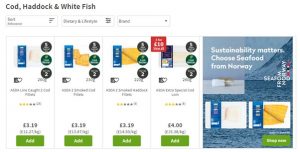
However, other than a sticker, there is nothing to indicate the fish is from Norway and now that the promotion has concluded, shoppers will be none the wiser, given that the stickers are no longer present.
For Waitrose, the Grocer states that the NSC will seek to increase consumer purchases of frozen own label MSC certified cod and haddock. They will advertise in Waitrose’s weekend and food publications and launch a shopper competition with celebrity chef, Jose Pizarro.
In store, this promotion was not immediately apparent. In some stores visited, the promotion was one sided so only visible to shoppers approaching from one direction. A couple of stores visited had labelling visible from both ends of the aisle. Having said that, the signage was small and almost impossible to read as it was located over an open freezer.

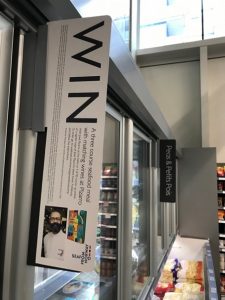

As is clear from the promotional material in store, the focus is more on winning a prize than promoting the fish. The frozen cod and haddock were on price promotion, but this was not mentioned. The 280g pack of two frozen cod fillets was priced at £5 saving a £1 and equating to £17.85/kg. The pack is simply described as Waitrose 2 cod fillets but there is no mention of origin. The back of the pack simply states: ‘Fish responsibly sourced. Seine and Trawl caught in the North East Atlantic’.
Although the packs of chilled cod and haddock do not have a stated origin, packs of cod loin are clearly labelled as Icelandic.

The NSC promotion is featured in the Waitrose Food magazine.
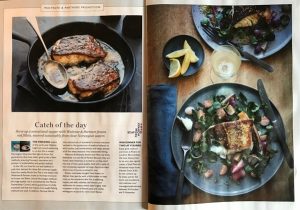
There is a double page spread on page 132/133 out of 138 pages which talks about the sustainability of Norwegian fish. The article states that like all Norwegian seafood, this high-quality cod is accredited by the Marine Stewardship Council which guarantees that it is fully traceable and that low-impact line-caught fishing methods are used.

This is a bit puzzling since as mentioned above the pack states that the fish in the pack is seine and trawl caught. Also, not all Norwegian seafood is MSC certified. Certainly, their salmon is not.
The article mentions that Norway has its own national set of standards to ensure everyone involved in the production of seafood adheres to the strict quotas and certifications and keeps abreast of all the latest research into sustainable fishing. That is all well and good, but in a magazine about Food I would rather be reading how good the fish tastes and what good eating it makes.
Finally, there was an opportunity to win a prize courtesy of the NSC. This is dinner in London at Pizarro. I know that the NSC has an office in London, but Waitrose are spread across the country from Stirling in Scotland to Truro in Cornwall. It seems a bit parsimonious not to offer travel and accommodation as part of the prize or have a prize that is not London based. The ten runners up get a copy of Jose Pizarro’s cookbook Andalusia, an area which last time I looked had little to do with Norway.
On the competition page of the website, the instructions were to complete a form and answer one simple question. I suspect the question for most entrants was where was the question. In fact, I suspect most entrants just visited Waitrose’s competition page and entered the competition along with other current competitions and had never even seen, let alone bought, a piece of Norwegian fish. It was just another of several competitions run by the retailer.
At least Asda shoppers got a free, if somewhat unusable, sticker with their purchase.

Have these promotions been a success? My view will depend on what criteria are used to judge them. It’s likely that the intention has more to do with impressing the Norwegian Seafood Council’s feepayers than UK consumers!
Closed: It comes as no surprise to learn that Sainsbury’s are closing all their fish counters in order to reduce costs during the Covid pandemic. The counters had been closed since the first lockdown, but I could not see them reopening as they appeared to me to be struggling to attract shoppers well before Covid hit. A spokesman for Sainsbury’s said that customer shopping habits are changing, and we have taken the decision to permanently close our fish counters.
By comparison, Tesco did reopen some of their counters recently, but these too seem to have attracted little consumer interest. I would not be too surprised if I heard that these were to close too.

